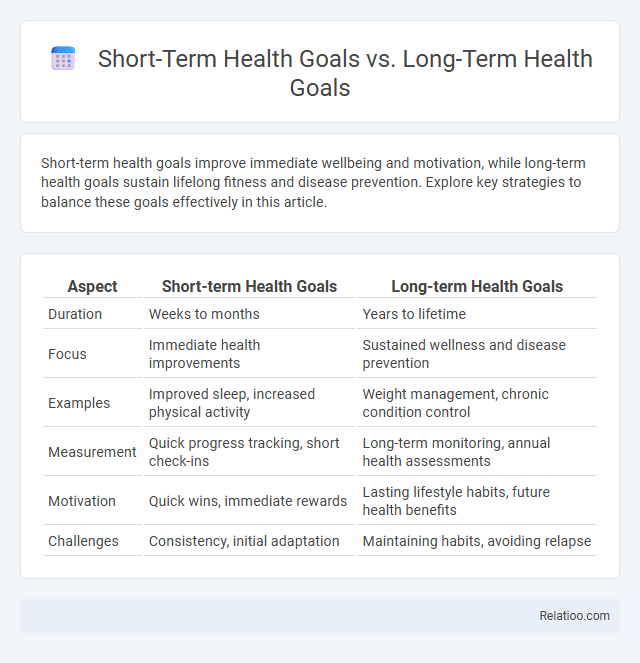Short-term health goals improve immediate wellbeing and motivation, while long-term health goals sustain lifelong fitness and disease prevention. Explore key strategies to balance these goals effectively in this article.
Table of Comparison
| Aspect | Short-term Health Goals | Long-term Health Goals |
|---|---|---|
| Duration | Weeks to months | Years to lifetime |
| Focus | Immediate health improvements | Sustained wellness and disease prevention |
| Examples | Improved sleep, increased physical activity | Weight management, chronic condition control |
| Measurement | Quick progress tracking, short check-ins | Long-term monitoring, annual health assessments |
| Motivation | Quick wins, immediate rewards | Lasting lifestyle habits, future health benefits |
| Challenges | Consistency, initial adaptation | Maintaining habits, avoiding relapse |
Understanding Short-term Health Goals
Short-term health goals focus on achievable, measurable actions such as increasing daily water intake, completing a weekly exercise routine, or improving sleep quality within days or weeks. These goals serve as foundational steps that build momentum and provide motivation toward long-term health improvements like sustained weight management or chronic disease prevention. Effective health planning incorporates short-term health goals by setting specific, time-bound targets that facilitate gradual, sustainable lifestyle changes.
Defining Long-term Health Goals
Long-term health goals focus on sustainable lifestyle changes that improve overall well-being over years, such as maintaining a healthy weight, managing chronic conditions, or improving cardiovascular health. Defining these goals requires assessing your current health status, personal values, and potential risks, ensuring they are realistic and measurable. Your health planning should integrate these long-term objectives with short-term milestones to track progress and adapt strategies effectively.
Key Differences Between Short-term and Long-term Health Goals
Short-term health goals are specific, achievable targets set to improve your well-being within days or weeks, such as increasing daily water intake or walking 10,000 steps. Long-term health goals focus on sustained improvements over months or years, like maintaining a healthy weight or managing chronic conditions effectively. Health planning integrates both short-term and long-term goals to create a balanced, sustainable approach tailored to your personal needs and lifestyle.
Benefits of Setting Short-term Health Goals
Setting short-term health goals provides immediate motivation and measurable milestones, enhancing adherence to a healthy lifestyle. These goals facilitate quick adjustments and personalized strategies, improving overall well-being by addressing specific health behaviors. Short-term targets also build confidence and momentum, which are essential for achieving long-term health objectives and sustaining effective health planning.
Advantages of Long-term Health Planning
Long-term health planning provides sustainable benefits by encouraging consistent lifestyle changes that reduce the risk of chronic diseases, improve mental well-being, and enhance overall quality of life over time. While short-term health goals offer quick motivation and measurable results, long-term plans promote lasting habits that support ongoing health improvements and prevent relapse. By focusing on your long-term health planning, you ensure a strategic approach to wellness that aligns with personalized preventive care and chronic condition management.
Common Short-term Health Goal Examples
Common short-term health goals include improving daily hydration, incorporating 30 minutes of exercise five times a week, and reducing sugar intake to manageable levels. These achievable targets provide immediate motivation and measurable progress compared to long-term health goals like managing chronic conditions or achieving sustainable weight loss. Health planning integrates both short-term and long-term objectives to create a comprehensive strategy that adapts to individual needs and promotes overall well-being.
Popular Long-term Health Goal Ideas
Popular long-term health goal ideas often include maintaining a balanced diet, achieving sustainable weight management, and committing to regular physical activity to prevent chronic diseases. Your health planning should integrate these objectives with short-term goals like daily exercise routines and meal planning to create achievable milestones. Prioritizing consistency and gradual lifestyle changes enhances the effectiveness of both short-term and long-term health goals in promoting overall well-being.
Strategies for Balancing Short-term and Long-term Goals
Balancing short-term and long-term health goals involves prioritizing immediate actions like daily exercise and balanced nutrition while maintaining focus on sustainable habits such as consistent weight management and chronic disease prevention. Effective strategies include setting SMART (Specific, Measurable, Achievable, Relevant, Time-bound) objectives, regularly monitoring progress through health tracking apps or medical check-ups, and adjusting plans based on evolving health needs. Integrating these approaches within comprehensive health planning enhances motivation, supports behavior change, and ensures alignment between quick wins and lifelong wellness outcomes.
Tracking Progress and Measuring Success
Tracking progress in short-term health goals involves frequent monitoring of specific actions like daily exercise or calorie intake, providing immediate feedback that encourages adherence. Long-term health goals require periodic evaluation using broader health indicators such as weight stability, blood pressure levels, or cardiovascular fitness improvements to measure sustained success. Effective health planning integrates both approaches by setting measurable milestones, utilizing tools like health apps or wearable devices, ensuring continuous assessment and timely adjustments to optimize overall wellness outcomes.
Tips for Achieving Both Short-term and Long-term Health Goals
Effective health planning integrates both short-term and long-term health goals by setting specific, measurable targets such as weekly exercise routines and annual health check-ups. Prioritize consistency and flexibility by tracking progress with apps or journals, while adjusting goals based on changes in lifestyle or health status. Incorporating balanced nutrition, regular physical activity, and stress management techniques supports sustainable health improvements and helps maintain motivation over time.

Infographic: Short-term Health Goals vs Long-term Health Goals
 relatioo.com
relatioo.com